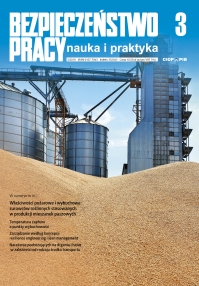Właściwości pożarowe i wybuchowe surowców roślinnych stosowanych w produkcji mieszanek paszowych
Fire and explosive properties of plant materials used in the production of compound feed
Author(s): Maciej Celiński, Agnieszka Gajek, Michał GlocSubject(s): Economy
Published by: Centralny Instytut Ochrony Pracy – Państwowy Instytut Badawczy
Keywords: grain: dust: silo: explosibility: lowest explosion limit, electrostatic discharge
Summary/Abstract: Extremely large scale of grain processing leads to a very high risk of incidents related to fire or dust explosion. Only in 2018 there were several outbreaks associated with the storage and transport of grain materials, the largest of which took place in May in South Sioux City, Nebraska. Poland is one of the largest grain producers in Europe and in the world. The annual grain production in Poland is about 35 million tons, including about 10 million tons of wheat, 5 million tons of triticale, 4 million tons of barley and 1.5 million tons of oats. Such an amount of grain material means that there is a high probability of failure during the storage processes (i.e. drying, pouring), transport and processing. Current research shows that of all dust explosions, those related to the food-agricultural and fodder industry account for nearly 25%. The most vulnerable are silos, dedusting and ventilation systems (including dryers and warehouses for drying grains). In October 2013, in the BulkTerminal in Gdańsk, there was an explosion and fire in a grain silo. The rescue operation lasted nearly 4 hours and about 10 tons of grain have burned (20% of the total stored grain material). The purpose of this article is to describe the results of research on the phenomenon of flammability and explosibility of industrial dusts on the four most popular grains in Poland.
Journal: Bezpieczeństwo Pracy. Nauka i Praktyka
- Issue Year: 570/2019
- Issue No: 3
- Page Range: 11-14
- Page Count: 4
- Language: Polish

